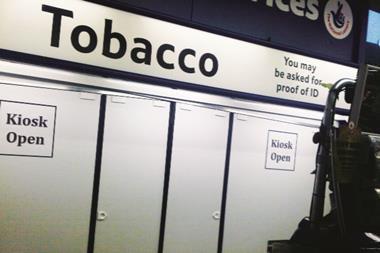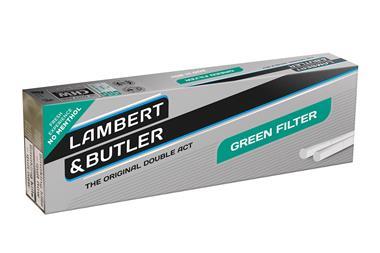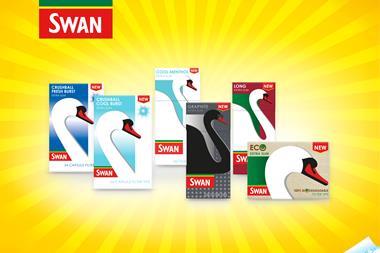This year could prove a momentous one for the tobacco industry and give small stores the chance to set their tobacco sales alight, says Gaelle Walker
These days tobacco is very rarely out of the headlines, and this year looks set to be no different. In less than two months a tobacco display ban will be enforced in stores over 3,000sq ft in England, and a national consultation into plain packaging is also sailing onto the horizon.
However, despite these challenges the UK’s tobacco manufacturers remain bullish about the category’s future, and they believe that you should be optimistic, too, if you’re a small store retailer serving the 12 million UK adults who still choose to smoke.
Manufacturers and wholesalers believe that small stores have a great chance to profit once their larger counterparts go dark, by adhering to a few key guidelines around availability, ranging and service. Early indications demonstrate that their claims appear to be well-founded. Spar retailer Neil Norton in Kidderminster is reporting a rise in his weekly tobacco sales following his local Tesco supermarket’s decision to comply with the display ban ahead of the April deadline.

He says: “Tobacco is one of the largest categories in terms of sales in our store, and since opening in September we have seen our sales increase steadily month on month, and particularly in the past month, as a result of some of the local supermarkets going dark ahead of the tobacco display ban.
“Once they’ve all gone dark I’m expecting our sales to go through the roof as we’re pretty much the only convenience store in this area,” Neil says.
Small stores such as Neil’s would also be wise to pay much closer attention to their sales data in order to identify and exploit any new trends which might result from this new customer base, JTI head
of communications Jeremy Blackburn advises.
Premier retailer Dan Cock of Whitstone Stores, Holsworthy, Devon, is determined to do this. “One thing that I have really taken away from Booker’s excellent D Day conferences on exploiting the ban is the need to capture customer data,” he says. “We’ll be keeping our standards high, but also striving to understand where our new customers are coming from and why. Exit surveys are a useful way of doing this, or just ask people at the till and then make a note of their replies.”
Staff training, adds Palmer and Harvey marketing director Richard Hayhoe, will also be imperative. “The only way you will get any of this right is if each member of your staff is on board - any investment of time or money in training them now will pay dividends in sales later,” he says.
“Tobacco is not going to go away with the display ban, but it will become a more complicated category to understand and manage,” Hayhoe points out. Palmer and Harvey is rolling out a retailer education programme to help retailers.
Large convenience stores can also minimise the negative impacts of a tobacco display ban by sticking to sound retailing principles such as following the market trends, recognising the peak times for tobacco purchasing, and using this information to carefully plan how much stock to buy and the best times of the day to restock tobacco units, Imperial Tobacco’s Iain Watkins adds.
Having well-trained staff who know where products are located on the unit will also help reduce serving times and speed up re-stocking, he points out.
And if you believe that there will be fewer brands around after the ban then think again. Tobacco manufacturers say they certainly won’t be calling time on new product development and innovation in the tobacco category once gantries go dark.
New innovations and launches will continue in line with demand, says Ian Robertson, head of corporate and regulatory affairs at BAT UK. And BAT should know, having launched Vogue Perle in Ireland - a dark market - in September 2011. In the four months from launch until the end of 2011, Vogue Perle sold 1.7 million sticks.
Manufacturers say the dark market will force them to think more creatively when it comes to marketing new tobacco products. Ideas such as ‘pack swap’ campaigns at adult events such as horse and motor racing are likely to become more important.
Retailers may also have to be more pro-active when it comes to selling new products. “With products out of sight, adult smokers will be increasingly reliant on retailers for information,” he says.
However, a tobacco display ban and a plain packaging consultation are not the only challenges that tobacco retailers should be gearing up for this year. The Olympic Games, running from July 27 until August 12, will present tobacco retailers with a golden opportunity to add sales, but the event poses its own problems, too.
“The 2012 Olympics will see vast numbers of UK adult smokers travelling around the country,” explains Watkins. Given that adult smokers’ brand preferences vary so significantly across the UK, this influx of people from Scotland, Northern England, Wales and the Midlands into London is likely to mean that sales of certain brands will increase, he argues.
A look at the panel above shows just how sales of Imperial Tobacco’s Lambert & Butler brand vary across the UK.
“Retailers will need to ensure their tobacco units have the appropriate number of facings and their store rooms are well-stocked in order to meet the increase in demand,” Watkins adds.
The fact that the Olympics will also lead to a huge influx of travellers from foreign countries into the UK means that retailers would be wise to review their tobacco ranges, and perhaps buy in a selection of the most popular European cigarette brands such as Camel, Pall Mall, Winston, Marlboro, and particularly Marlboro Red, for which Phillip Morris expects to see a significant increase in demand.
Retailers located in and around London and the other Olympic venues of Glasgow, Cardiff, Coventry, Manchester, Birmingham, Weymouth and Portland, who purchase their tobacco via cash and carries should also start making plans for these trips. With about 60 miles of road closures planned in London alone congestion and disruption is highly likely. The 2012 Games’ planners have recently published details of the roads affected by the Olympic Route Network (ORN) and Paralympic Route Network (PRN) on www.london2012.com. Road closures will mean that many retailers will be limited to making trips to their local cash and carry between midnight and 6am. Others will need to prepare for longer journey times, more time away from their stores, or the prospect of reducing the number of visits they make to cash and carries and buying more stock on each visit.
Cigarettes: the state of play
Adult smokers in the UK spend about £12bn a year on their favoured cigarette brands. Despite some modest decreases in sales volumes, this value figure has actually increased over the past few years - driven largely by high tax rises handed down by the Chancellor.
Combined with the current economic climate and high unemployment, these rises mean that the desire for cigarette brands which offer value for money has never been greater. Almost one in three cigarettes sold in the UK is now a value brand, and value cigarettes are currently the fastest growing segment of the total tobacco market, accounting for 29.3% volume share of the total cigarette market and growing, JTI data shows. It’s a fact which has led to an almost unprecedented level of new product launches and reclassifications in past months.
JTI reduced the cost price and rrp of its Berkeley cigarettes at the end of last year. Its Berkeley’s Superkings range of 10s and 20s now feature a reduced rrp of £2.96 and £5.78 respectively, while the new King Size formats have an rrp of £2.93 (10s) and £5.73 (20s). BAT also launched a new low-priced offering in the form of Rothmans Gold and Rothmans Silver, which was followed a few days later by the birth of Imperial Tobacco’s Player’s brand at the lowest end of the current pricing spectrum. All of the above are available in pricemarked packs (PMPS), the value of which should not be underestimated this year, Imperial’s Watkins adds.
“In the present economic climate sales of PMPs are growing. Retailers could lose tobacco sales, and the impulse purchases made with them, if they do not realise the commercial value provided by PMPs,” he adds.
However, not everyone is thrilled by this budget bonanza. In fact, Dan Cock argues that the proliferation of brands on the gantry is confusing adult smokers. “All manufacturers are doing is fighting among themselves, diluting the market and blurring the gantry,” he says.
Moving in the opposite direction are the premium priced segments which, in addition to offering the retailer more attractive margins, still account for about one in four of all packs of cigarettes purchased.
In a bid to pep up sales in this sector, manufacturers have also been busy trying to add value to these pricier picks with a wash of packaging refreshes and innovative new designs. From February 1, Imperial Tobacco made Lambert & Butler King Size Gold and Menthol 20s available in new Glide-Tec packs, replacing the existing holographic packs for King Size 20s.
“Glide-Tec packs provide retailers with a significant opportunity as they provide added value,” Watkins explains. “Pack innovations such as Glide-Tec are perceived as offering added value and will help retailers protect their margins,” he says.
JTI also launched three limited-edition pack designs for its premium cigarette brand Benson & Hedges Gold, while BAT’s premium Vogue Signature brand was made available in a compact pack with a new metallic finish for both Bleue and Menthe variants.
But when it comes to innovation, the one thing that’s really set tongues wagging has been the launch of capsule cigarettes in the UK. The cigarettes, which have small menthol capsules embedded in their filters, represent “the biggest innovation within the tobacco category since the launch of the filter,” according to BAT. Squeezing the filter and breaking open the capsule releases a fresh burst of flavour into the cigarette, allowing the adult smoker to choose if they want to smoke a regular tasting cigarette, or a menthol one.
Data from other European countries such as France and Spain, which already sell capsule cigarettes, show them to be particularly popular with female smokers under the age of 30. However, given the strong value trend in the UK, the two-in-one proposition means that they will likely prove popular with a much broader spectrum of adult smokers.
The past couple of months have seen almost all of the UK’s key players bring out capsule products here, starting with JTI’s Silk Cut Choice in King Size 20s in December. Just a couple of weeks later BAT followed suit with new Pall Mall Click On introduced in the value sector.
Pall Mall Click On is available now in King Size 19s format with a launch pricemark of £5.33, before moving to the rrp of £5.47.
“Capsule technology has the potential to change everything,” BAT’s Robertson adds. “The capsule innovation offers adult smokers the freedom to choose when and if they want to change the taste of the cigarette - an option that has never previously been available.”
Currently, only menthol capsules have been launched, but the potential to launch new flavours is there, and while it’s early days, none of the manufacturers have ruled out this option.•
























No comments yet